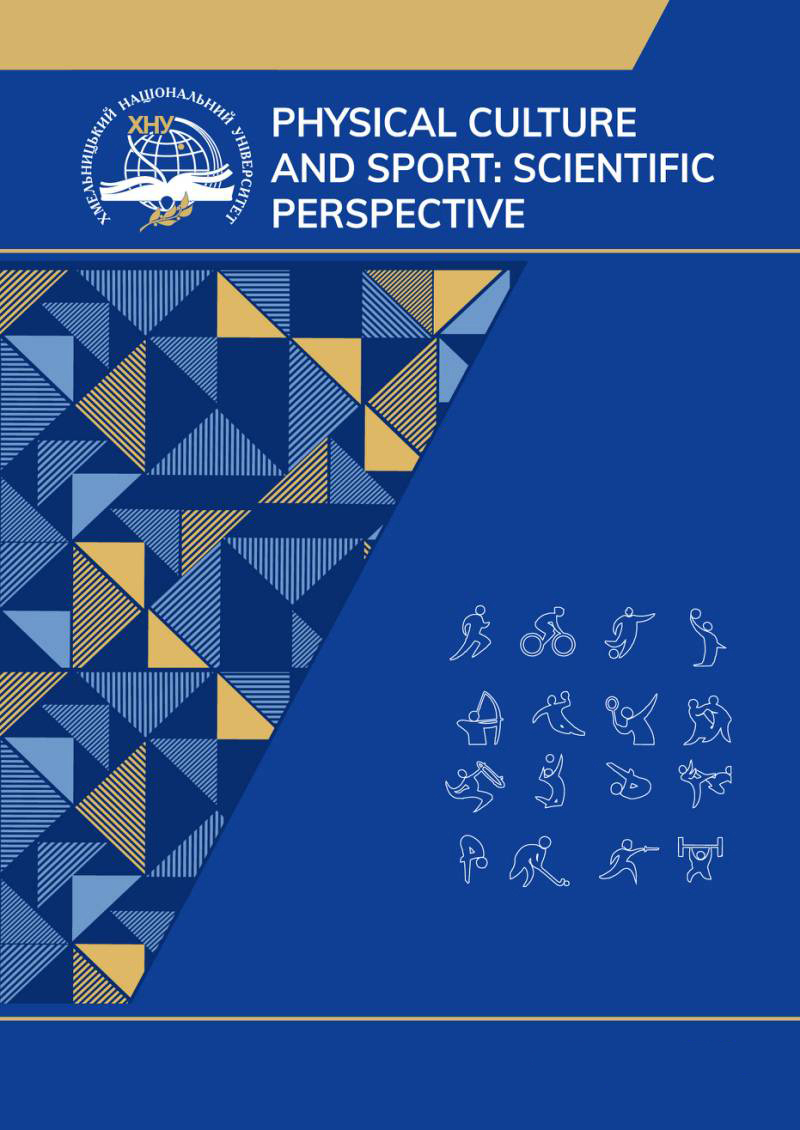Changes in special physical preparedness of taekwondo ITF athletes aged 12-13 resulting from the differentiation program of physical training
DOI:
https://doi.org/10.31891/pcs.2024.3.18Keywords:
effectiveness, differentiation, physical training, special preparedness, young athletes, taekwondo ITF, changesAbstract
In the process of generalizing the scientific and methodological information, the relevance of tackling the problem and revealing the effectiveness of a differentiated approach to the physical training of 12-13-year-old taekwondo ITF athletes has been determined. The aim of the study is to establish the effectiveness of a differentiated physical training program in various training cycles for 12-13-year-old taekwondo ITF athletes based on indicators of their special physical preparedness. Materials and Methods: The following research methods were used: theoretical analysis, generalization of data from references and the Internet, pedagogical testing, and methods of mathematical statistics. To control physical fitness, we relied on the recommendations of program-regulatory documents, with supplements made by taekwondo ITF specialists. The pedagogical experiment involved the implementation of the author’s program of physical training differentiation for 12-13-year-old taekwondo ITF athletes. In the period from September 2023 to June 2024, 42 young taekwondo (ITF) athletes from Ivano-Frankivsk took part in the experiment. Results: Trends, according to which the results of control drills of the experimental group had certain differences in the growth of indicators, have been revealed. For instance, single punches (in two variants for 10 and 120 seconds) were generally inferior in terms of percentage growth to single kicks of the same duration. Further on, the first variants of combinations of two and three punches also had smaller percentage improvements compared to the second variants of control drills. Among the representatives of the control group, trends were also revealed, according to which the results of control drills in the shorter duration variant had higher percentage indicators of result improvement. This was observed in all cases with no exceptions. Moreover, in general, combinations of three punches had slightly higher values of improvement compared to other variants of control drills. Conclusions: The effectiveness of a differentiated approach to the physical training of young taekwondo athletes has been proven. This effectiveness manifests inteslf in higher values of improvement compared to the traditional approach to training of taekwondo ITF athletes aged 12-13.
References
Voropai S., Nudha M., Sobko S., Sobko N. Vplyv zaniat z elementamy tkhekvondo na rozvytok koordynatsiinykh zdibnostei ditei molodshoho shkilnoho viku. Sportyvnyi visnyk Prydniprovia. 2016. № 1. S. 164–169.
Danyshchuk S., Yatsiv Ya., Hnatchuk Ya., Khrobatyn I. Aktualizatsiia kontroliu zahalnoi fizychnoi pidhotovlenosti sportsmeniv vikom 12–13 rokiv u taekvon-do ITF. Ukrainskyi zhurnal medytsyny, biolohii ta sportu. 2023, Tom 8, № 1 (41). S. 297–304. DOI: 10.26693/jmbs08.01.297
Danyshchuk S., Yatsiv Ya., Hnatchuk, Ya. Dyferentsiatsiia fizychnoi pidhotovky sportsmeniv vikom 12–13 rokiv u taekvon-do ITF: perspektyvy doslidzhen. Naukovyi chasopys Natsionalnoho pedahohichnoho universytetu imeni M. P. Drahomanova. Seriia 15. Naukovo-pedahohichni problemy fizychnoi kultury (fizychna kultura i sport), № 10 (155). S. 65-70.
Zadorozhna O. R., Briskin Yu. A., Pityn M. P. Taktyka u suchasnykh olimpiiskykh sportyvnykh yedynoborstvakh: monohrafiia. Lviv. LDUFK im. Ivana Boberskoho, 2023. 416 s.
Lynets M.M., Chychkan O.A., Hnatchuk Ya.I. [ta in.] Dyferentsiatsiia fizychnoi pidhotovky sportsmeniv: monohrafiia / za zah.red. M.M.Lyntsia. Lviv: LDUFK, 2017. 304s.
Lukina O. V. Optymizatsiia spetsialnoi fizychnoi pidhotovlenosti yunykh tkhekvondystiv na etapi poperednoi bazovoi pidhotovky: avtoref. dys... k.fiz.vykh.: 24.00.01. Dnipropetrovsk, 2009. 20 s.
Lukina O., Novikov V., Horbenko V. Spetsialna fizychna pidhotovlenist yunykh tkhekvondystiv na etapi poperednoi bazovoi pidhotovky. Sportyvnyi visnyk Prydniprovia. 2010. № 3. S. 71–76.
Liuchkova Ye. Koordynatsiini zdibnosti u trenuvalnii ta zmahalnii diialnosti tkhekvondystiv. Fizychna kultura i sport. Vyklyky suchasnosti : zb. st. nauk.-prakt. konf., Kharkiv: KhNPU, 2021. S. 69–73.
Nemtseva Yu., Kravchuk T. Analiz tekhnichnoi pidhotovlenosti tkhekvondystiv u zmahalnykh poiedynkakh. PhysicalEducationTheoryandMethodology, 2021. № 1. S. 41–44.
Omelianenko D. O., Ananchenko K.V. Pakulin S. L. Udoskonalennia protsesu pidhotovky taekvondystiv. Naukovyi chasopys NPU imeni M.P. Drahomanova. Seriia 15. 2017. Vyp. 7 (89). S. 12–16.
Sanzharova N. M., Popova M. V. Vplyv zasobiv tkhekvondo na riven rozvytku hnuchkosti khlopchykiv molodshoho shkilnoho viku. Teoriia ta metodyka fizychnoho vykhovannia. 2015. № 2. S. 15–19. DOI: 10.17309/ tmfv.2015.2.1137
Taekvon-do I.T.F.: Navchalna prohrama dlia dytiacho-yunatskykh sportyvnykh shkil. Kyiv, 2010. 39 s.
Koshcheyev A. Technical training in the non-olympic taekwondo (poomsae) direction during the initial preparation phase. Fizychna kultura, sport ta zdorovia natsii. 2019. Vyp. 8. S. 157–164.
Pityn M., Sogor O., Karatnyk I., Hnatchuk Y., Blavt O. Improvement of the Structure and Content of an Annual Training Macrocycle for Young Pankration Athletes. Teorìâ Ta Metodika FìzičnogoVihovannâ, 2021. 21(3), rr. 185–193.
Prystupa E., Okopnyy A., Hutsul N., KhimenesKh., Kotelnyk A., Hryb I., Pityn M. Development of special physical qualities skilled kickboxers various style of competitive activity. Journal of Physical Educationand Sport. 2019. Vol 19 (Supplementissue 2). Pp. 273–280.
Downloads
Published
How to Cite
Issue
Section
License
Copyright (c) 2024 Сергій ДАНИЩУК , Ярослав ЯЦІВ , Ярослав ГНАТЧУК , Андрій ДАНИЩУК

This work is licensed under a Creative Commons Attribution 4.0 International License.





